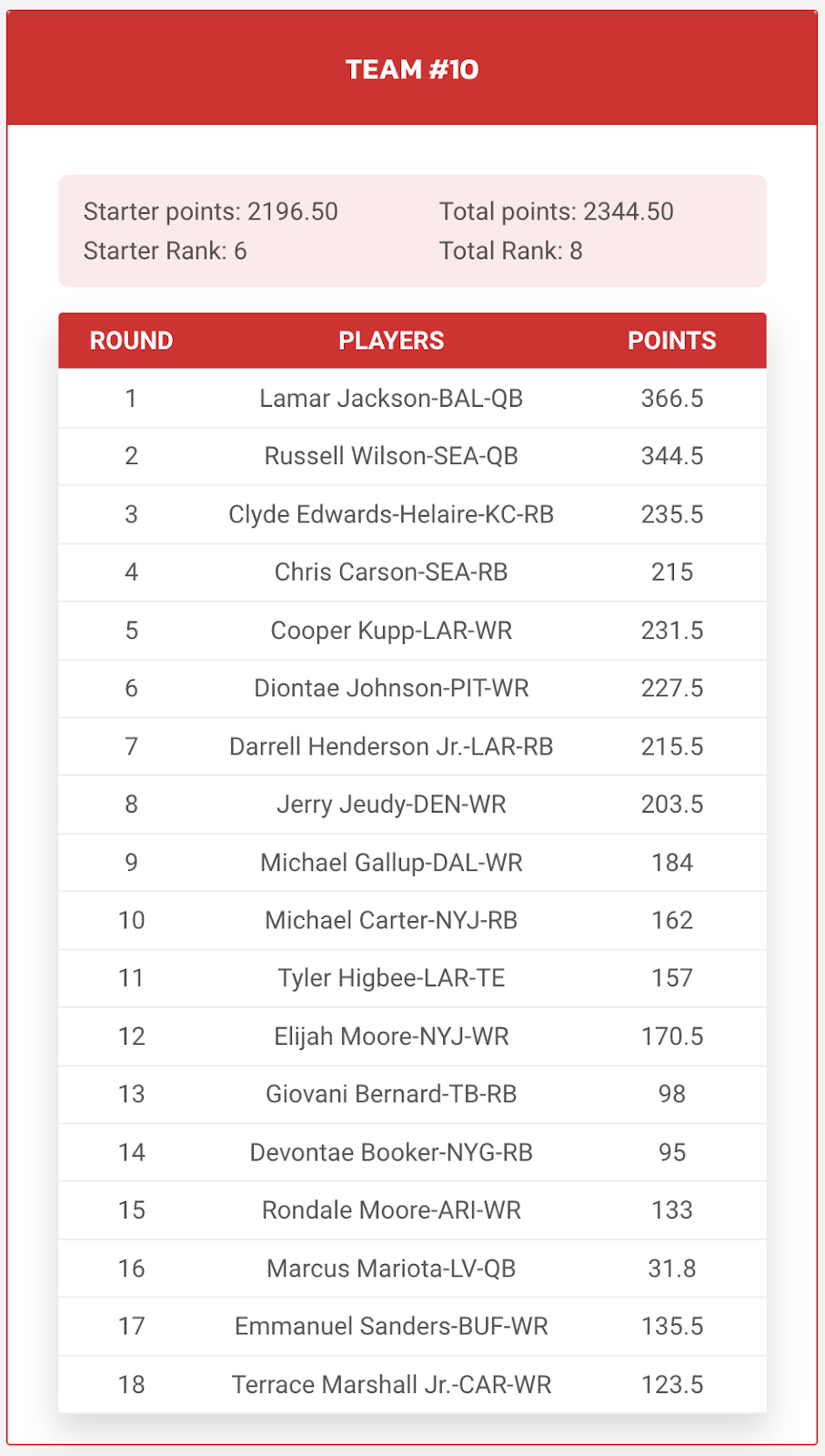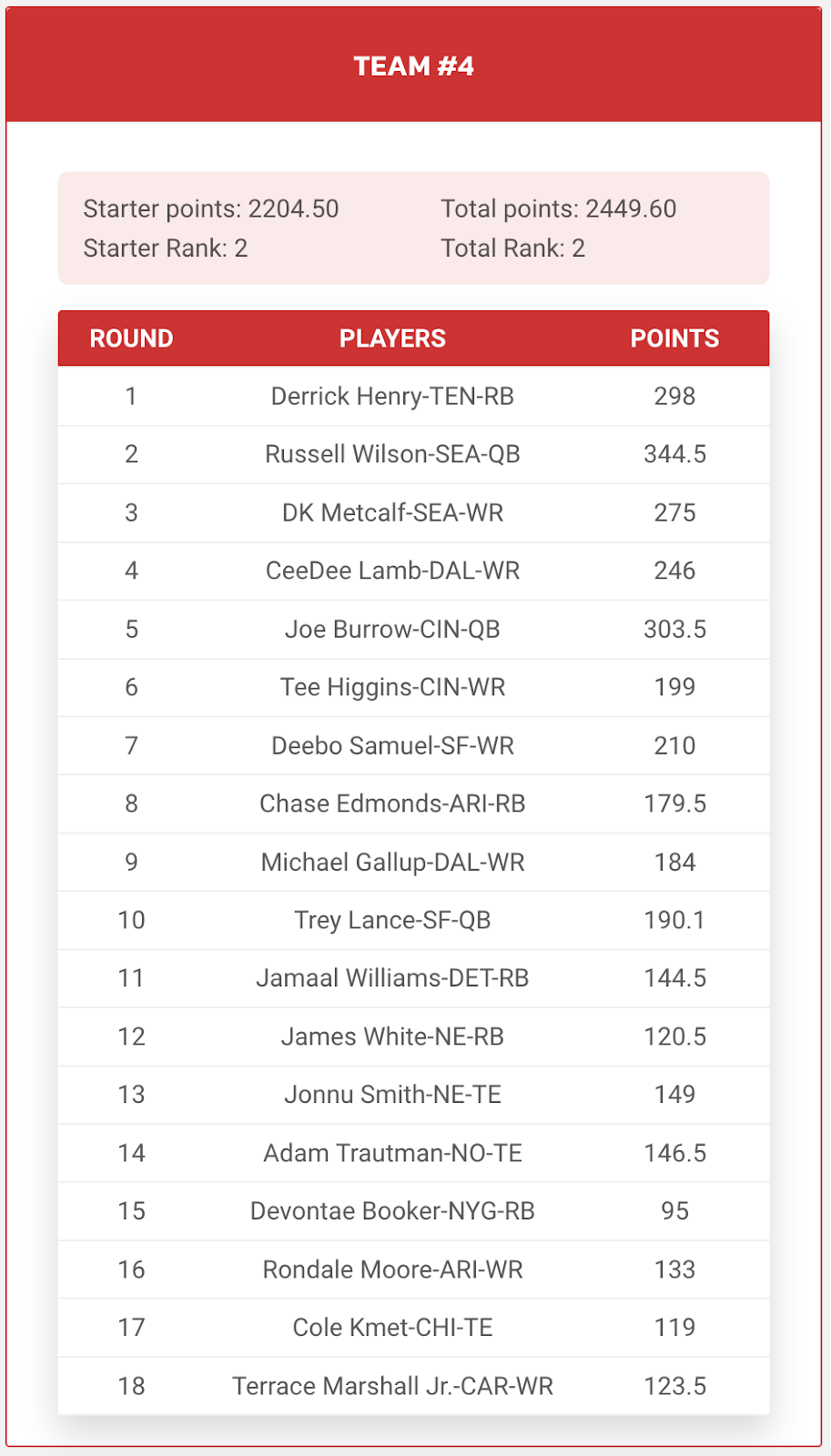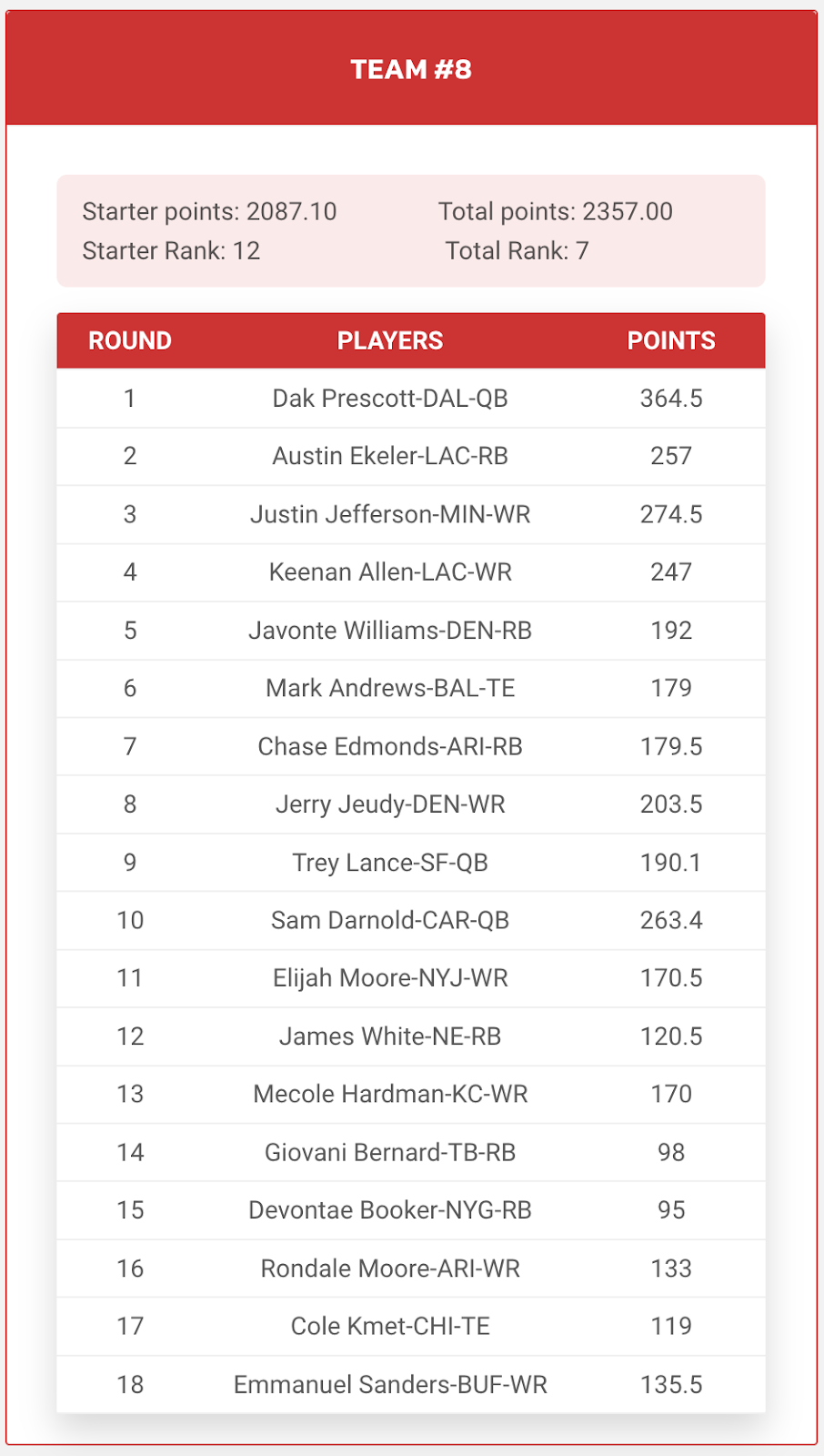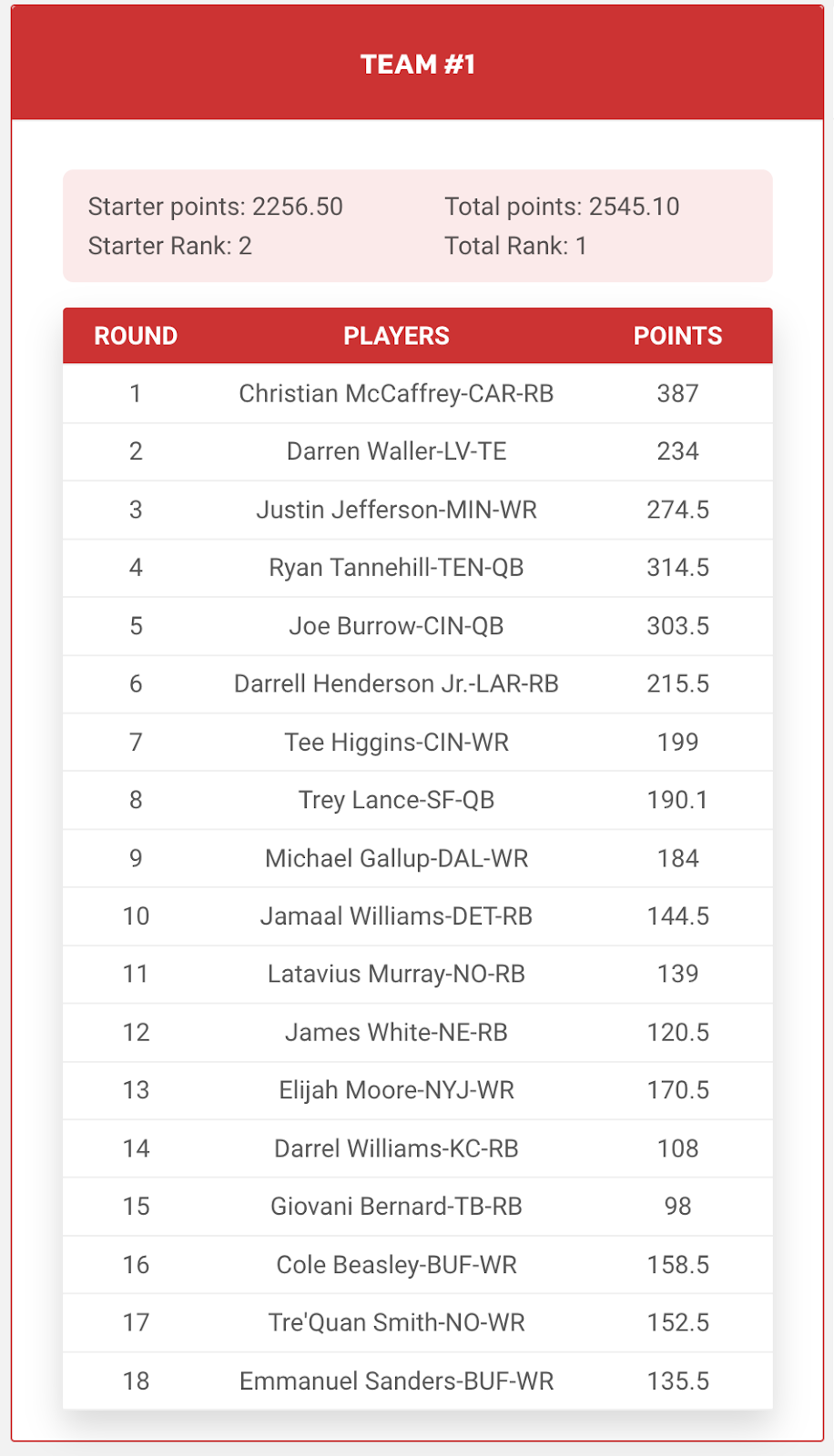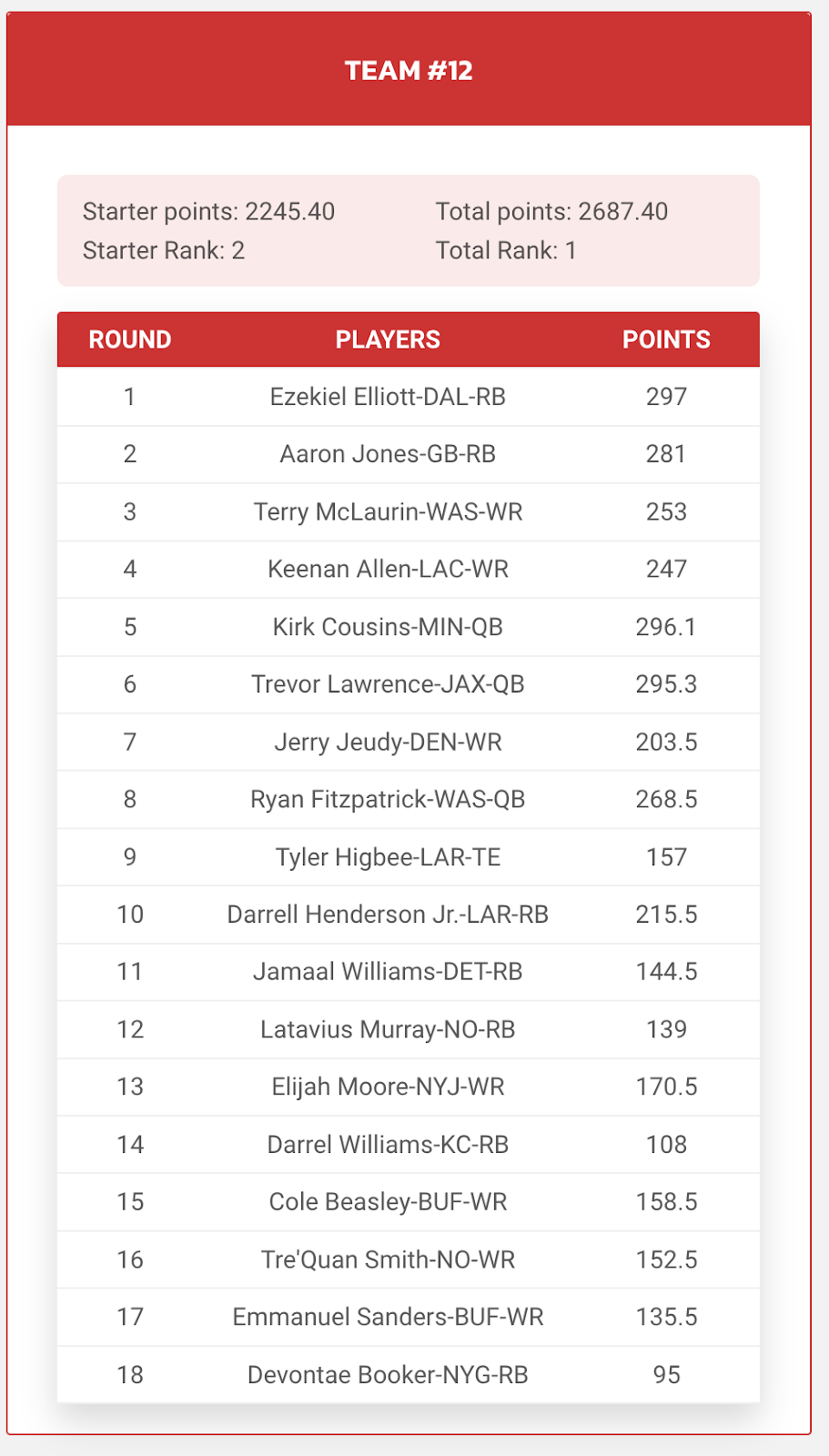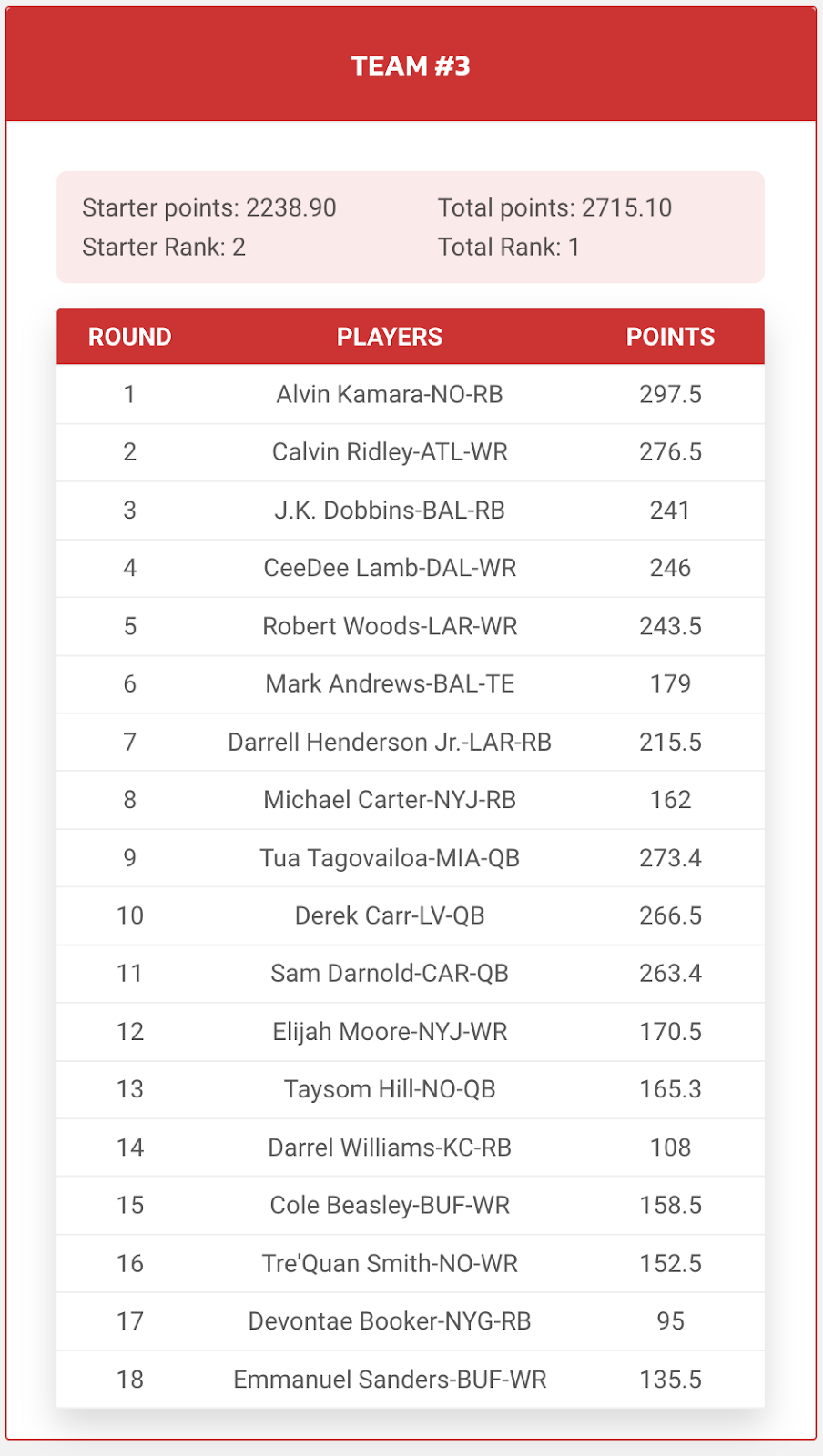It has been a slow burn, but SuperFlex leagues are finally gaining popularity and joining the mainstream as a viable alternative to standard setups. Since there are usually 25-28 startable quarterbacks in any given week in fantasy, SuperFlex leagues solve the scarcity problem we see arise in standard 1-QB leagues.
Unlike in tight end premium leagues (1.5 PPR points to TEs) where the gap between Travis Kelce and whoever the TE12 in fantasy points is gets wider and more pronounced, SuperFlex formats actually help make all quarterbacks more valuable. While you’d almost never consider playing guys like Daniel Jones or Jared Goff in typical 10-team, 1-QB leagues — Jones and Goff become viable, week-in, week-out starters.
Most SuperFlex formats give you the “flexibility” to start 2 QBs but only force you to start one. While that added option to not start a second QB is nice during bye weeks or when injury strikes, you are going to want to start a QB2 every single time in that FLEX spot.
The math is simple. Let’s stick with the Jones and Goff example and run through some hypotheticals.
Last year, Goff was the QB23 in fantasy points per game (15.9) while Jones was the QB31 (12.8). These two were the definition of replaceable in 1-QB leagues. Meaning, you could always find someone like Goff or Jones on the waiver wire to pick up, stream them, and expect somewhere between 12-16 points. While you can get away with the bargain bin quarterbacks for a week or two if you’re in a bind, you should never accept 12-16 FPG from your starting QB in 1-QB leagues. Ever. The gap between Goff and QB1 Josh Allen was a massive 9.9 points per game.
However, in SuperFlex leagues, the player universe expands and guys like Goff and Jones are not just weekly starters… they might be values in your draft.
Goff’s 15.9 FPG wouldn’t have even been on your radar in 1-QB leagues, but that output would have been good enough to out-score last year’s RB13 Josh Jacobs (15.7). Jones’ 12.8 FPG was pitiful in 1-QB, but it would have matched the WR38 in FPG Tyler Boyd.
So, guys like Goff, Jones, and other replacement-level QBs are usable again in SuperFlex formats. Great! Now what?
Let’s talk strategy:
How many QBs to take?
I’m a huge proponent of doing away with D/ST and Kickers in season-long leagues. How many times have you been beaten because the Patriots D/ST scored 30 points and the D/ST you picked up on the waiver wire scored 3? You might have a team that is five times better than the guy or gal with the Pats’ D/ST, but in the week you matched up, it didn’t matter.
SuperFlex leagues provide not only just another starting position, they also make the decision to rid your leagues of defenses and kickers a lot easier. So, that’s an added bonus!
All right. Let’s say you’re firing up a new SuperFlex league where there are 12 teams and you start 1 QB, 2 RBs, 3 WRs, 1 TE, 1 “normal” FLEX (RB / WR / TE), and 1 SuperFlex (QB / RB / WR / TE). So you’ll have 9 normal starters and let’s say 9 bench players to back them up.
In this setup, all 12 teams are undoubtedly going to want to start two QBs every week (for a total of 24 in play). But, as we know, bye weeks are pesky and injuries happen.
To be safe, I’d recommend drafting at least three QBs in every single SuperFlex league. You can get away with just drafting two studs, but we’ll talk more about that later.
Now, the combination of these three QBs is pretty much limitless, but you’ll most commonly see teams built like this: 1 QB in the top-12 by ADP, 1 QB in the top-24, and then 1 more QB that’s on the Taysom Hill / Teddy Bridgewater spectrum. My personal preference is to have three viable starters every week guaranteed, but there is obviously merit to waiting on that third QB and playing the waiting game with ambiguous job security.
Adjusting to the SuperFlex market
If you spend all off-season getting ready for 1-QB leagues and then you’re thrown into a SuperFlex draft with no preparation, there won’t be much overlap in what you’re used to.
While the QB12 by ADP in 1-QB leagues goes around the 100 overall mark in the 9th round, the QB12 in SuperFlex usually goes somewhere in the 35-50 overall range. So, basically, your normal 1-QB overall rankings need to bake in about 30-50 slot adjustment depending on how early/late you are in the draft. The rankings at the bottom of this article make that adjustment and give you an idea of where and when to take your QB1, QB2, and QB on your team.
So, on average, be prepared for a 2-to-7 round jump in quarterback ADP when comparing 1-QB to SuperFlex formats.
The best thing about SuperFlex is it changes strategy so much and forces teams to adjust more on the fly. In general, you’ll see anywhere from 7-9 running backs go off of the board in the first round of 1-QB leagues. In SuperFlex? There are usually a minimum of 5 QBs taken in the first.
Let’s dive deep on some draft strategies and go through those examples using our excellent and recently updated Fantasy Points Generator.
Note: All of the sample drafts in this article have the following setup in the generator:
12 teams
1 QB, 2 RBs, 3 WRs, 1 TE, 1 FLEX (RB / WR / TE), and 1 SuperFlex (QB / RB / WR / TE, set up as a second starting QB) as starters (9 total)
9 bench slots
PPR scoring for RB / WR / TE
4-points per TD for QBs
NOTE: To set up a SuperFlex draft in the Fantasy Points Generator, place “2” in the starting QB requirements, since you’re almost always going to want a QB in that slot anyway.
Check out my tutorial using the Fantasy Points Generator for Superflex leagues here.
Two Studs
The name of this strategy speaks for itself. You want to bludgeon your leaguemates week in, and week out with two high-upside QBs and not have to worry about who to start on Sunday mornings.
While locking in a floor of 35 points and having the upside of 50-60 combined between your 2 QBs every single week is certainly appealing, it comes with an opportunity cost. What does your depth look like at your other starting spots?
Here are a few sample team’s I drafted using the FPG.
The first one is from 3 overall, which is primed for Patrick Mahomes.
Mahomes and Jalen Hurts are a sweet pairing, but I have to admit that I’m pretty underwhelmed with the way my running backs look here. I love Antonio Gibson in the second round, but RB2-4 could be a problem unless Damien Harris or Michael Carter breaks out. And if Gibson goes down, I’d better hope I played the waiver wire well. The wide receivers are sick, though. That’ll be a common theme that you’ll notice in all of these sample drafts. Receiver is deeper than ever.
Ok, let’s look at this another way. Let’s draft two stud quarterbacks from the back-half of the first round out of the 10 hole and see how that shakes out.
Alright, so off the bat, this team is much stronger at running back than the previous team from the 3 spot. Lamar Jackson and Russell Wilson is such a ridiculously good pairing that I just punted my QB3 with Marcus Mariota late. Wide receiver might be a problem, though. While my 3 starters are Cooper Kupp, Diontae Johnson, and then one of Jerry Jeudy or Michael Gallup the team next to me (9 overall) went with just one stud QB (Dak Prescott) and then with 2 cheap late-rounders (Derek Carr and Sam Darnold). Team 9’s starting WRs are Davante Adams, Justin Jefferson, and Allen Robinson. His WR4 is Brandon Aiyuk.
And therein lies the rub with the two-stud strategy. No matter when you’re drafting from overall, early or late, you’re going to be much weaker at either running back or wide receiver than a few of your opponents. Still, Lamar and Wilson have a chance to combine for 55-60 points alone four or five times a year. That is such a massive difference in your two highest-scoring slots and can theoretically float your entire roster even if you have league-average to slightly above-average starters at RB or WR. Two studs makes the most sense in deeper 12-teamers where that positional advantage at the highest scoring potential starting slots matters most.
One Stud + Mid-Rounder + Late-Rounder
Ok, so, the 2 stud approach offers a massive positional advantage at quarterback and you can set and forget that spot, but it’s bound to leave you weak at one of running back or wide receiver.
What happens if we take a stud first or second rounder and then follow that up with a mid-round option at QB2 and a late round QB3?
Here’s a look at that strategy from 4 overall:
Now we’re talking. I probably got a little lucky with Russell Wilson falling into the second, but you get the general idea here. Justin Herbert was also on the board in the second. I’m stacked at receiver and feel great about Derrick Henry as my anchor RB1 followed up with some mid- to late-round darts. Joe Burrow is a fantastic QB2 target in the 4th or 5th round of drafts and I have two pairings between Burrow-Higgins and Wilson-Metcalf that make a ton of sense from an upside perspective. Tight end is a bit lackluster, but I’m completely fine throwing darts there if I miss out on Kelce, Waller, or Kittle. Honestly, I was targeting Waller in the third round, but Team 3 took him right before me. Dammit, Team 3.
One Stud + Two Streamers
One other variation of the One Stud strategy is to take it just a step further and target two options in the later rounds and then just pick between that pairing every week. You also get a small added benefit of not having to worry about whether or not you have a hole at QB3, too.
Let’s pick from the 8 hole.
The 8-10 spot is a dead zone in any draft, and this team is a reflection of that. At the very least, I’ve got a top-10 option at every starting position and Justin Jefferson and Keenan Allen is an awesome duo, too.
2 or 3 Mid- to Late-Rounders
We’ve spent most of the time drafting studs, but it’s time to change things up.
I’m a huge proponent of drafting QBs in the mid-rounds of 1-QB leagues when the RB and WR pool starts to tighten up. I’m actively targeting Lamar Jackson or Dak Prescott in the sixth round when I already have the majority of my starting RBs and WRs filled out. While we don’t have that same luxury in SuperFlex, there is enough depth at the position for a modified mid-round QB strategy to work.
Let’s take a look at a mid-round QB strategy from the front- and back-half of the first round…
From 1 overall:
And from 12 overall:
So, both of these teams project out as No. 2 in starter points despite being drafted at opposite ends of the board (1 and 12). If you get the 1.01 this year, CMC is a lock, but then you miss out on the entire top-8 QB range. Because of that, I like the idea of turning around at the Round 2 / 3 turn and taking Darren Waller and a receiver to give you two non-QB positional advantages at RB and TE. The 12th overall team has a similar sort of strategy, but is just a bit weaker at QB and is especially weaker at TE.
Overall, the mid-round strategy is somewhat risky, but can pay off in a big way if you draw a pick at or near the turns and you play the QB board right. However, every draft room is different and if there is a run on QBs and you get caught out at the end of it, you could be staring down Daniel Jones or Tua Tagovailoa as your QB1. Gross.
YOLO QB
How confident are you that you can find the right late-round QBs? While the rest of your league hammers QBs in the first 6-7 rounds, you load up at every other position and try to secure advantages at running back, wide receiver, and tight end. This isn’t for the faint of heart, but with a fairly deep QB pool of 25-28 passers, it’s worth considering if you keep getting sniped on QBs.
Let’s run a YOLO QB team from the 3 hole:
The optimizer loves this team from an overall projection standpoint. Alvin Kamara / J.K. Dobbins are a great duo and the WR trio of Calvin Ridley / CeeDee Lamb / Robert Woods is what dreams are made of. That said, you likely are going to want to secure an advantage at TE for this strategy to work, too. Otherwise, you’re probably going to find it hard to make up the scoring hole at QB. On average, my QBs on this team are probably only good for 12-16 FPG apiece, which shakes out to 24-32 combined.
Final Thoughts, Quick Hits
My favorite all-around strategy and teams are the ones that feature One Stud + Mid-Rounder + Late-Rounder. You go QB in the first or second, take your second QB in Round 4-6 (like Ryan Tannehill or Joe Burrow), and then take Trey Lance or Justin Fields late. With the way ADP has set up, it’s the best blend of QB strategy without completely sacrificing your running back and receiver depth. I’m typically a very balanced player, though, and I never take unnecessary risks with the way I construct teams. So, this might be my personal drafting bias seeping in, but this strategy will work in every single format from shallow 10-team SuperFlex leagues to deeper 12- and 14-teamers.
2-3 Mid-Rounders is the second-best variation of strategy. While everyone chases QBs early, you stack up your RB / WR depth or take an elite tight end. Since the league is only going to start 20 QBs total every week instead of 24, you can get wild with your late-round combinations and take as many as 4 options if your bench is deep enough.
On that note, Lance and Fields need to be a part of your draft plan regardless of the way you’re building your teams. They both have the rushing upside we’re always looking for and have been getting dinged all summer because neither is expected to start Week 1. Who cares, though? You’re getting high-end QB1 upside at a low-end QB2 price and it’s easy to stop-gap them early in the year with guys like Sam Darnold, Jared Goff, or Cam Newton until the rookies take over.
Rolling with a Two Stud strategy makes more sense in deeper 12-team leagues or 14-teamers and less sense in shallower 10-teamers. Everyone is going to have some small holes at RB / WR in 12- or 14-team leagues anyway, which makes securing a positional advantage at your QB slot even more important. I did a version of this strategy in the Scott Fish Bowl, where my first 12 picks were (from 11 overall): Russell Wilson / Darren Waller / Matthew Stafford / Keenan Allen / Chris Carson / Julio Jones / Adam Thielen / Deebo Samuel / Chase Edmonds / Michael Gallup / Marquise Brown / Darrell Henderson.
Finally, Ryan Tannehill sets up as the best value overall at the position. Over the last two seasons, Tannehill has been one of the most efficient passers in the game — ranking second-best in passer rating, second-best in touchdown rate, first in yards per attempt, and second-best in fantasy points per dropback. If the Titans defense continues to regress and gives up more points, it’ll give Tannehill and the passing attack even more upside with a few more pass attempts per game. You’re getting high-end, high-floor QB1 production in the 3rd and 4th rounds of drafts and, if you target him, you have the flexibility to adopt any strategy. Tannehill can be a part of a Two Stud build, a Mid-Rounder squad, or as a part of a One Stud + Streamers team.
Rankings — Updated 9/3
Note: The players themselves are in the same exact order as our Top-200 overall rankings, just with a baked-in adjustment for QB value and scarcity.
| Overall | Name | Position Rank | Team | Bye |
| 1 | Christian McCaffrey | RB1 | CAR | 13 |
| 2 | Dalvin Cook | RB2 | MIN | 7 |
| 3 | Patrick Mahomes | QB1 | KC | 12 |
| 4 | Alvin Kamara | RB3 | NO | 6 |
| 5 | Ezekiel Elliott | RB4 | DAL | 7 |
| 6 | Josh Allen | QB2 | BUF | 7 |
| 7 | Lamar Jackson | QB3 | BAL | 8 |
| 8 | Kyler Murray | QB4 | ARI | 12 |
| 9 | Travis Kelce | TE1 | KC | 12 |
| 10 | Derrick Henry | RB5 | TEN | 13 |
| 11 | Dak Prescott | QB5 | DAL | 7 |
| 12 | Tyreek Hill | WR1 | KC | 12 |
| 13 | Davante Adams | WR2 | GB | 13 |
| 14 | Russell Wilson | QB6 | SEA | 9 |
| 15 | Saquon Barkley | RB6 | NYG | 10 |
| 16 | Aaron Jones | RB7 | GB | 13 |
| 17 | Jonathan Taylor | RB8 | IND | 14 |
| 18 | Antonio Gibson | RB9 | WAS | 9 |
| 19 | Austin Ekeler | RB10 | LAC | 7 |
| 20 | Aaron Rodgers | QB7 | GB | 13 |
| 21 | Stefon Diggs | WR3 | BUF | 7 |
| 22 | Nick Chubb | RB11 | CLE | 13 |
| 23 | Najee Harris | RB12 | PIT | 7 |
| 24 | Joe Mixon | RB13 | CIN | 10 |
| 25 | Calvin Ridley | WR4 | ATL | 6 |
| 26 | DK Metcalf | WR5 | SEA | 9 |
| 27 | Justin Jefferson | WR6 | MIN | 7 |
| 28 | DeAndre Hopkins | WR7 | ARI | 12 |
| 29 | Darren Waller | TE2 | LV | 8 |
| 30 | Tom Brady | QB8 | TB | 9 |
| 31 | Clyde Edwards-Helaire | RB14 | KC | 12 |
| 32 | Terry McLaurin | WR8 | WAS | 9 |
| 33 | Keenan Allen | WR9 | LAC | 7 |
| 34 | Allen Robinson II | WR10 | CHI | 10 |
| 35 | CeeDee Lamb | WR11 | DAL | 7 |
| 36 | A.J. Brown | WR12 | TEN | 13 |
| 37 | David Montgomery | RB15 | CHI | 10 |
| 38 | George Kittle | TE3 | SF | 6 |
| 39 | Matthew Stafford | QB9 | LAR | 11 |
| 40 | Jalen Hurts | QB10 | PHI | 14 |
| 41 | Justin Herbert | QB11 | LAC | 7 |
| 42 | Ryan Tannehill | QB12 | TEN | 13 |
| 43 | Robert Woods | WR13 | LAR | 11 |
| 44 | D'Andre Swift | RB16 | DET | 9 |
| 45 | James Robinson | RB17 | JAX | 7 |
| 46 | Adam Thielen | WR14 | MIN | 7 |
| 47 | Amari Cooper | WR15 | DAL | 7 |
| 48 | Mike Evans | WR16 | TB | 9 |
| 49 | Miles Sanders | RB18 | PHI | 14 |
| 50 | Chris Carson | RB19 | SEA | 9 |
| 51 | Javonte Williams | RB20 | DEN | 11 |
| 52 | Gus Edwards | RB21 | BAL | 8 |
| 53 | Cooper Kupp | WR17 | LAR | 11 |
| 54 | Chris Godwin | WR18 | TB | 9 |
| 55 | Diontae Johnson | WR19 | PIT | 7 |
| 56 | Tyler Lockett | WR20 | SEA | 9 |
| 57 | Joe Burrow | QB13 | CIN | 10 |
| 58 | Brandon Aiyuk | WR21 | SF | 6 |
| 59 | Chase Claypool | WR22 | PIT | 7 |
| 60 | Josh Jacobs | RB22 | LV | 8 |
| 61 | DJ Moore | WR23 | CAR | 13 |
| 62 | Ja'Marr Chase | WR24 | CIN | 10 |
| 63 | Jerry Jeudy | WR25 | DEN | 11 |
| 64 | Tee Higgins | WR26 | CIN | 10 |
| 65 | Baker Mayfield | QB14 | CLE | 13 |
| 66 | T.J. Hockenson | TE4 | DET | 9 |
| 67 | Mark Andrews | TE5 | BAL | 8 |
| 68 | Kyle Pitts | TE6 | ATL | 6 |
| 69 | Justin Fields | QB15 | CHI | 10 |
| 70 | Trey Lance | QB16 | SF | 6 |
| 71 | Kirk Cousins | QB17 | MIN | 7 |
| 72 | Trevor Lawrence | QB18 | JAX | 7 |
| 73 | Tua Tagovailoa | QB19 | MIA | 14 |
| 74 | Mike Davis | RB23 | ATL | 6 |
| 75 | Kareem Hunt | RB24 | CLE | 13 |
| 76 | Chase Edmonds | RB25 | ARI | 12 |
| 77 | Deebo Samuel | WR27 | SF | 6 |
| 78 | Julio Jones | WR28 | TEN | 13 |
| 79 | Trey Sermon | RB26 | SF | 6 |
| 80 | Myles Gaskin | RB27 | MIA | 14 |
| 81 | Damien Harris | RB28 | NE | 14 |
| 82 | A.J. Dillon | RB29 | GB | 13 |
| 83 | Darrell Henderson Jr. | RB30 | LAR | 11 |
| 84 | DeVonta Smith | WR29 | PHI | 14 |
| 85 | Michael Pittman Jr. | WR30 | IND | 14 |
| 86 | Darnell Mooney | WR31 | CHI | 10 |
| 87 | Tyler Boyd | WR32 | CIN | 10 |
| 88 | Robby Anderson | WR33 | CAR | 13 |
| 89 | Logan Thomas | TE7 | WAS | 9 |
| 90 | Sony Michel | RB31 | LAR | 11 |
| 91 | Raheem Mostert | RB32 | SF | 6 |
| 92 | Michael Gallup | WR34 | DAL | 7 |
| 93 | Odell Beckham Jr. | WR35 | CLE | 13 |
| 94 | Ben Roethlisberger | QB20 | PIT | 7 |
| 95 | Matt Ryan | QB21 | ATL | 6 |
| 96 | Ryan Fitzpatrick | QB22 | WAS | 9 |
| 97 | Kenny Golladay | WR36 | NYG | 10 |
| 98 | Antonio Brown | WR37 | TB | 9 |
| 99 | JuJu Smith-Schuster | WR38 | PIT | 7 |
| 100 | Marquise Brown | WR39 | BAL | 8 |
| 101 | Laviska Shenault Jr. | WR40 | JAX | 7 |
| 102 | Courtland Sutton | WR41 | DEN | 11 |
| 103 | Kenyan Drake | RB33 | LV | 8 |
| 104 | Michael Carter | RB34 | NYJ | 6 |
| 105 | Jamaal Williams | RB35 | DET | 9 |
| 106 | Robert Tonyan | TE8 | GB | 13 |
| 107 | Derek Carr | QB23 | LV | 8 |
| 108 | Sam Darnold | QB24 | CAR | 13 |
| 109 | Zach Wilson | QB25 | NYJ | 6 |
| 110 | Daniel Jones | QB26 | NYG | 10 |
| 111 | Zack Moss | RB36 | BUF | 7 |
| 112 | Ronald Jones II | RB37 | TB | 9 |
| 113 | Jarvis Landry | WR42 | CLE | 13 |
| 114 | Jaylen Waddle | WR43 | MIA | 14 |
| 115 | Noah Fant | TE9 | DEN | 11 |
| 116 | Dallas Goedert | TE10 | PHI | 14 |
| 117 | Tyler Higbee | TE11 | LAR | 11 |
| 118 | Elijah Moore | WR44 | NYJ | 6 |
| 119 | DeVante Parker | WR45 | MIA | 14 |
| 120 | Brandin Cooks | WR46 | HOU | 10 |
| 121 | DJ Chark Jr. | WR47 | JAX | 7 |
| 122 | Corey Davis | WR48 | NYJ | 6 |
| 123 | Marquez Callaway | WR49 | NO | 6 |
| 124 | Mecole Hardman | WR50 | KC | 12 |
| 125 | Carson Wentz | QB27 | IND | 14 |
| 126 | Teddy Bridgewater | QB28 | DEN | 11 |
| 127 | Jameis Winston | QB29 | NO | 6 |
| 128 | Michael Thomas | WR51 | NO | 6 |
| 129 | Marvin Jones Jr. | WR52 | JAX | 7 |
| 130 | Mike Williams | WR53 | LAC | 7 |
| 131 | William Fuller V | WR54 | MIA | 14 |
| 132 | Jonnu Smith | TE12 | NE | 14 |
| 133 | Jared Goff | QB30 | DET | 9 |
| 134 | Mike Gesicki | TE13 | MIA | 14 |
| 135 | David Johnson | RB38 | HOU | 10 |
| 136 | Leonard Fournette | RB39 | TB | 9 |
| 137 | Tony Pollard | RB40 | DAL | 7 |
| 138 | Melvin Gordon III | RB41 | DEN | 11 |
| 139 | Jakobi Meyers | WR55 | NE | 14 |
| 140 | Sterling Shepard | WR56 | NYG | 10 |
| 141 | Mac Jones | QB31 | NE | 14 |
| 142 | Tyrod Taylor | QB32 | HOU | 10 |
| 143 | James White | RB42 | NE | 14 |
| 144 | Bryan Edwards | WR57 | LV | 8 |
| 145 | Russell Gage | WR58 | ATL | 6 |
| 146 | Curtis Samuel | WR59 | WAS | 9 |
| 147 | Jimmy Garoppolo | QB33 | SF | 6 |
| 148 | Devin Singletary | RB43 | BUF | 7 |
| 149 | James Conner | RB44 | ARI | 12 |
| 150 | Henry Ruggs III | WR60 | LV | 8 |
| 151 | Rondale Moore | WR61 | ARI | 12 |
| 152 | Nyheim Hines | RB45 | IND | 14 |
| 153 | Phillip Lindsay | RB46 | HOU | 10 |
| 154 | J.D. McKissic | RB47 | WAS | 9 |
| 155 | Giovani Bernard | RB48 | TB | 9 |
| 156 | Damien Williams | RB49 | CHI | 10 |
| 157 | Parris Campbell | WR62 | IND | 14 |
| 158 | Gabriel Davis | WR63 | BUF | 7 |
| 159 | Jalen Reagor | WR64 | PHI | 14 |
| 160 | Kenneth Gainwell | RB50 | PHI | 14 |
| 161 | Alexander Mattison | RB51 | MIN | 7 |
| 162 | Cole Beasley | WR65 | BUF | 7 |
| 163 | Emmanuel Sanders | WR66 | BUF | 7 |
| 164 | Terrace Marshall Jr. | WR67 | CAR | 13 |
| 165 | Evan Engram | TE14 | NYG | 10 |
| 166 | Rob Gronkowski | TE15 | TB | 9 |
| 167 | Amon-Ra St. Brown | WR68 | DET | 9 |
| 168 | Tyrell Williams | WR69 | DET | 9 |
| 169 | Nelson Agholor | WR70 | NE | 14 |
| 170 | A.J. Green | WR71 | ARI | 12 |
| 171 | Rashaad Penny | RB52 | SEA | 9 |
| 172 | Darrel Williams | RB53 | KC | 12 |
| 173 | Latavius Murray | RB54 | NO | 6 |
| 174 | Tre'Quan Smith | WR72 | NO | 6 |
| 175 | Marquez Valdes-Scantling | WR73 | GB | 13 |
| 176 | Austin Hooper | TE16 | CLE | 13 |
| 177 | Taysom Hill | QB34 | NO | 6 |
| 178 | Devontae Booker | RB55 | NYG | 10 |
| 179 | Carlos Hyde | RB56 | JAX | 7 |
| 180 | Randall Cobb | WR74 | GB | 13 |
| 181 | Wayne Gallman | RB57 | ATL | 6 |
| 182 | Jamison Crowder | WR76 | NYJ | 6 |
| 183 | Cam Newton | QB35 | NE | 14 |
| 184 | Anthony Firkser | TE17 | TEN | 13 |
| 185 | Gerald Everett | TE18 | SEA | 9 |
| 186 | Cole Kmet | TE19 | CHI | 10 |
| 187 | Blake Jarwin | TE20 | DAL | 7 |
| 188 | Tony Jones Jr. | RB58 | NO | 6 |
| 189 | Adam Trautman | TE22 | NO | 6 |
| 190 | Christian Kirk | WR77 | ARI | 12 |
| 191 | K.J. Hamler | WR78 | DEN | 11 |
| 192 | Quez Watkins | WR79 | PHI | 14 |
| 193 | Byron Pringle | WR80 | KC | 12 |
| 194 | Sammy Watkins | WR81 | BAL | 8 |
| 195 | Zach Ertz | TE23 | PHI | 14 |
| 196 | Hunter Henry | TE24 | NE | 14 |
| 197 | Davis Mills | QB36 | HOU | 10 |
| 198 | Drew Lock | QB37 | DEN | 11 |
| 199 | Jacob Eason | QB38 | IND | 14 |
| 200 | Andy Dalton | QB39 | CHI | 10 |



